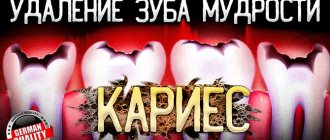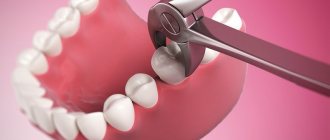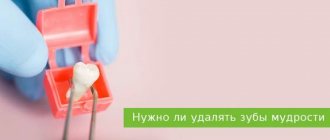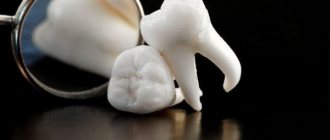When is molar tooth extraction indicated?
Only an experienced doctor can make an adequate decision about whether it is necessary or not to remove a molar tooth after a thorough examination. For detailed diagnostics, not only a visual examination is used, but also an analysis of the results of radiography or visiography. Indications for the removal of permanent teeth can be divided into absolute (in which the tooth requires mandatory removal) and relative (in these cases, the opinions of doctors may be divided).
Mandatory removal of a molar tooth is indicated in the following cases:
- there is a high probability that odontogenic osteomyelitis will develop;
- there is a risk of developing phlegmon or abscess.
- tooth root fracture.
Among the relative indications for the removal of molars are the following:
- if due to a dental disease, inflammation has developed in the area of a specific tooth (sinusitis);
- with longitudinal fractures of the tooth root;
- if the root and coronal part are so badly destroyed that therapeutic treatment is fraught with serious difficulties;
- if during the treatment of root canals their walls were damaged;
- tooth mobility is in the third or fourth degree;
- a fracture of the alveolar process, on the line of which the tooth is located, was diagnosed;
- in the oral cavity there are pathologies occurring around dystopic or impacted teeth;
- if orthopedic treatment is being carried out and certain molars cannot be used as support;
- if an orthopedic dentist or orthodontist has prescribed removal of molars and premolars.
As for the relative indications for molar tooth extraction, if you disagree with the opinion of one specialist, you should consult with another. This will help you choose the most gentle treatment and, possibly, save teeth that are at risk of removal.
Cost of the procedure.
Modern tooth extraction at the A-medic clinic is fast, painless and of high quality. We offer affordable prices for all types of dental services. If complex surgical intervention is required, our specialists carefully prepare for the operation and comply with all standards for its implementation.
The extraction procedure can be of different types, depending on the complexity the price will vary. Simple removal of a single-rooted or baby tooth does not take much time and does not require additional tools. In A-medic, its cost will be only 2,200 rubles. If the patient has a complex case, for example, he needs to remove the lower wisdom tooth, the operation will be painless, thanks to the use of modern painkillers. The price of conduction anesthesia is 500 rubles, after its installation, you completely stop feeling anything, while maintaining clarity of consciousness.
Our clinic has existed for 14 years, over these years we have earned a good reputation. We employ highly qualified specialists with international diplomas. For ease of payment, we offer our clients the option of installment plans*. A-medic has two branches that are within walking distance from metro stations, one on 1st Dubrovskaya street, 13, the other on st. Generala Belov, 51 building 1.
*Check the conditions with the administrator.
Is it painful to remove molars?
Modern dentistry uses the latest drugs for local anesthesia when removing molars. Therefore, the patient should not be afraid of pain or serious discomfort during the process of tooth extraction. The thinnest needles are used to administer anesthetic injections into the gum area, so the injection is virtually painless.
Prices for wisdom tooth removal on the lower and upper jaw
The cost of removal surgery in Moscow varies between 2500-9500 rubles. The specific cost of the service will be announced by the doctor after an x-ray, examination, assessment of health status and individual characteristics. The specialists of our dental clinic perform the extraction of the 8 painlessly and quickly. The high qualifications of maxillofacial surgeons, professionalism, and extensive experience speak in our favor. By contacting Dr. Razumenko’s dentistry, you can be sure of the quality of the operation and normal recovery during the rehabilitation period after removal. This is evidenced by numerous positive reviews.
You can find out how much it costs to remove a wisdom tooth and make an appointment for a consultation by calling.
| Code no. | Name of procedures | Unit of measurement | Cost, rub. |
| 611 | Removal of exostosis | 4 500,00 |
* The prices indicated on the website are not a public offer. The exact cost of treatment can only be determined at an appointment with a doctor.
Prices for treatment in Moscow full price list
Share on social media networks:
Article Expert:
Lavrentyev Sergey Sergeevich
Doctor - dentist, surgeon, implantologist. He regularly improves his professional level and studies modern methods of dental implantation and surgical dentistry at international seminars and conferences of outstanding implant surgeons in the world.
Work experience 25 years
Stages of molar removal
Before deciding to remove a molar tooth, the dentist conducts an examination using radiography or visiography. Based on the results of image analysis, the choice of surgical intervention technique is made. The procedure is then carried out in the following steps:
- An anesthetic drug is injected into the gum area, which leads to numbness in the patient’s mouth; Ultracain and Septanest are used in the Optimal Choice clinics.
- the ligaments that hold the tooth in the socket and the gums are peeled off using a special tool in order to reduce the risk of rupture of the soft tissues of the oral cavity;
- forceps are applied to the tooth or, in difficult cases, an elevator is used to loosen the damaged tooth, after which it is removed from the socket;
- the empty tooth socket is cleaned of tooth or bone fragments and checked for the presence of roots;
- if necessary, a hemostatic sponge is used or sutures are applied to stop bleeding.
After surgery, the doctor may prescribe analgesics to relieve pain after the anesthesia wears off.
Contraindications
Removal surgery cannot be performed in the presence of oncology, acute infectious/viral diseases, mental disorders, renal failure, circulatory failure, pregnancy in the 1st and 3rd trimesters.
Relative contraindications to removal are:
- carrying out prosthetics with a bridge structure, for which the tooth is a supporting element;
- absence of 6-7 molars, in which case the wisdom tooth is necessary for chewing food;
- allergy to drugs used for anesthesia during removal.
It is not worth removing a wisdom tooth without indications for this intervention, since the procedure is quite painful and complicated, even despite the availability of modern means of pain relief and diagnostics.
Possible complications
If the procedure for removing a molar tooth was carried out by a doctor without proper experience, sanitary and hygienic requirements were violated, or the patient violated medical recommendations, then there is a possibility of complications:
- heavy bleeding that cannot be stopped for a long time;
- inflammatory process in the socket caused by infection;
- jaw movements become limited due to problems with the masticatory muscles;
- the alveolus is exposed;
- sharp edges of the hole are formed;
- limited osteomyelitis is diagnosed in the socket from the extracted tooth.
Symptoms of developing pathologies can be severe pain, unpleasant odor from the mouth, purulent discharge from the socket, the appearance of white plaque on the alveoli and the onset of bleeding. In these cases, you should immediately contact your dentist.
Preventive measures
In order to avoid serious complications after molar tooth extraction, you need to follow a number of recommendations:
- 20 minutes after the end of medical procedures, the gauze swab should be removed from the socket of the extracted tooth;
- In order for healing to occur faster, you should not drink or eat for the first 2-3 hours after surgery;
- for several days you should avoid eating solid foods, as well as spicy and hot foods and drinks;
- hot water procedures and physical activity are contraindicated until the hole is completely healed;
- You cannot wash the hole yourself or try to clean it with foreign objects that have not been disinfected;
- During the first 24 hours after surgery, you should not rinse your mouth;
- A cold compress on the right side of the cheek will help prevent swelling and reduce the likelihood of bleeding.
If the hole does not heal for a long time or it seems that there are remains of a tooth in it, then you should contact your dentist again and under no circumstances try to solve these problems yourself.
Experts' opinion
Question: Is it possible to rinse your mouth after tooth extraction? If yes, then with what?
Answer : During the first 24 hours after a molar tooth has been removed, doctors at the Optimal Choice clinics do not recommend rinsing your mouth at all. Active rinsing of the mouth, even if its goal is to cleanse food debris, can lead to a number of negative consequences. The main danger is the destruction and washing out of the formed blood clot in the socket, which interferes with rapid healing. This can also lead to the development of alveolitis. In the first few days, instead of rinsing, it is better to use baths with a decoction of medicinal plants (sage, chamomile, oak bark), a weak solution of salt or baking soda (or a mixture of them in equal proportions), furatsilin, miramistin, chlorhexidine, if prescribed by a doctor.
Question: After tooth extraction, the gums hurt and swelling is noticeable. What to do?
Answer: Slight tissue swelling and pain are very often consequences of the removal of molars. For relatively tolerable pain, it is recommended to take analgesics prescribed by your doctor. If the pain is severe, then you urgently need to visit the dentist again for a check. A cold compress applied to the cheek on the side of the extracted tooth for 15-20 minutes will help relieve swelling.
Operation stages
Before surgery, a diagnosis is carried out, the type of anesthesia, and the method of performing the procedure are determined. A complex operation takes a long time and is very painful, so it is often performed under general anesthesia.
Removal is carried out in stages:
- pain relief with local anesthetics or general anesthesia;
- antiseptic treatment;
- dissection of the gums, peeling of the flap from the neck, root and bone;
- extraction of a molar using different techniques: pulling out entirely, in parts, with drilling a hole in the bone or removing part of the bone tissue;
- inspection of the hole, removal of broken fragments;
- treatment with drugs to prevent infection;
- suturing (usually self-absorbable material is used).
The operation lasts on average about one hour. If wisdom teeth are removed one by one, the interval between procedures is at least three weeks. When using general anesthesia, several dental units can be removed at once. After 2.3 days, the patient is examined by a doctor.
Possible complications
Any invasive procedure has consequences in the form of tissue swelling, pain, increased body temperature, general weakness, and drowsiness. As a rule, negative manifestations last for several days, then disappear without a trace.
What can a complex deletion of an eight lead to:
- bleeding, especially with high blood pressure, during menstruation, hemophilia;
- alveolitis (dry socket), which is characterized by inflammatory processes and increased pain due to the loss of a blood clot from the wound, requires the intervention of a surgeon;
- dislocation, fracture of an adjacent tooth due to excessive pressure from the elevator;
- paresthesia (loss of sensitivity of the jaw, soft tissues in the area of the operated area) due to damage to the tissue of the trigeminal nerve.
Difficult removal of a wisdom tooth in the lower jaw can lead to a fracture of the jaw bones. It occurs when there is a voluminous cyst at the apex of the root or osteoporosis if the doctor did not calculate the force and put too much pressure on the bone. This complication is extremely rare, since modern diagnostic methods make it possible to see all pathologies in the area of surgical intervention.
Postoperative period
After the procedure, the doctor gives the patient recommendations on nutrition, oral care, and prescribes medications. For several days you should not eat hot or cold food or drinks; you should chew solid food on the side that has not undergone surgery.
It is forbidden to overheat (beach, saunas, hot bath), this will increase bleeding. You should not smoke, as nicotine constricts blood vessels, which means the wound will heal slowly and may become inflamed with associated complications.
The patient is prescribed antibiotics to prevent the development of infections and inflammatory processes. To relieve attacks of pain, you can take analgesics. It is necessary to rinse your mouth daily with an antiseptic, such as chlorhexidine or regular saline solution. In this case, rinsing must be careful, since intense movement of the liquid may cause a blood clot to fall out.









